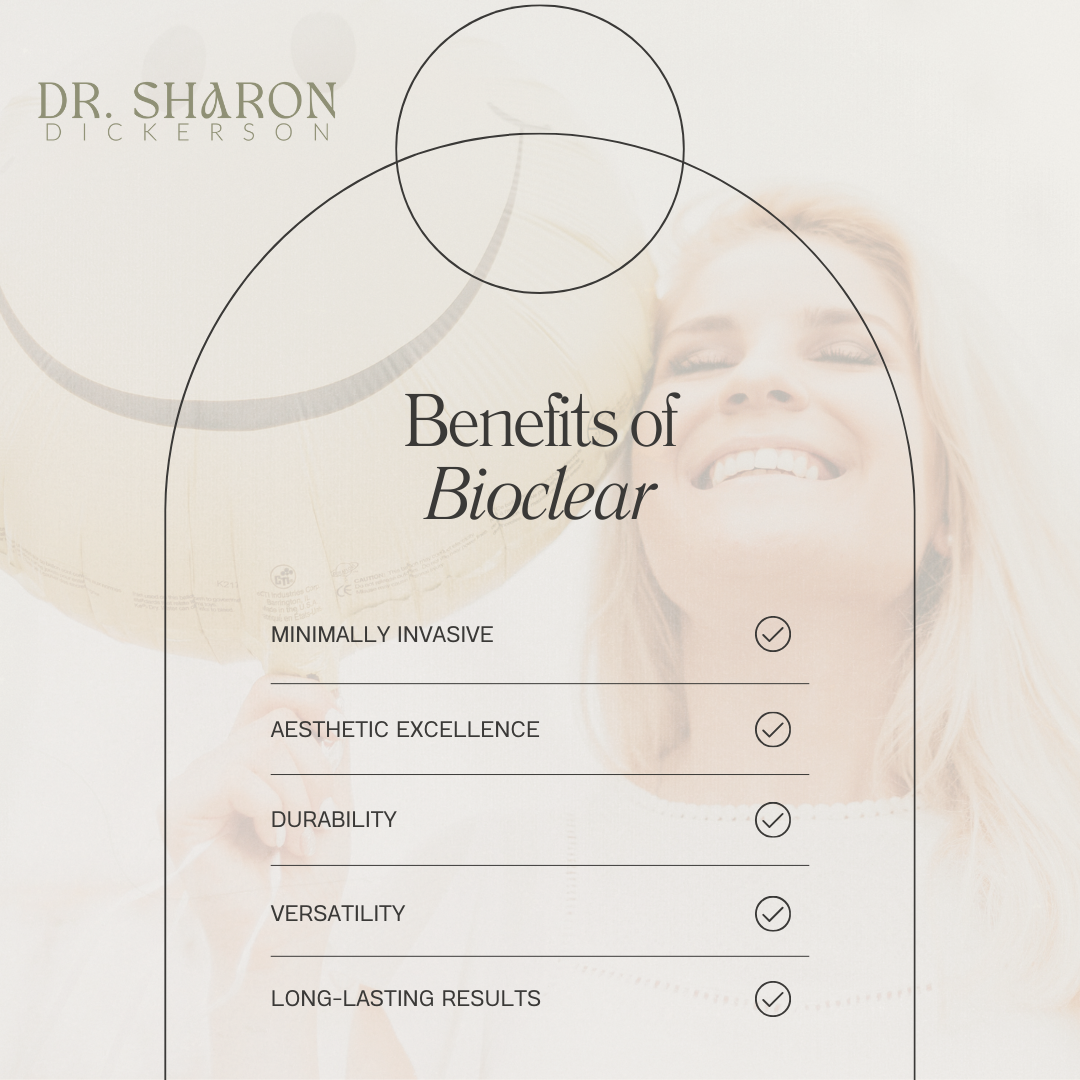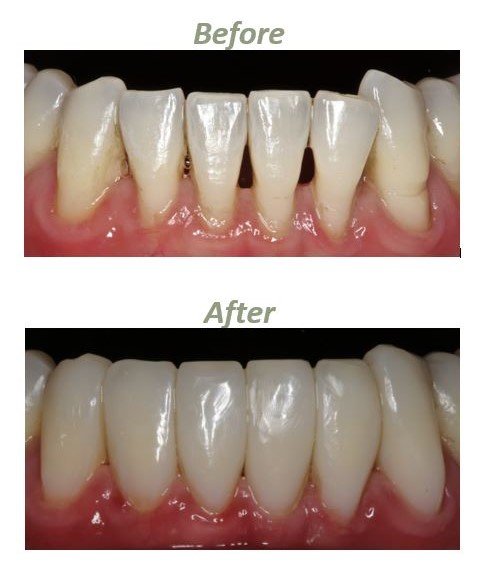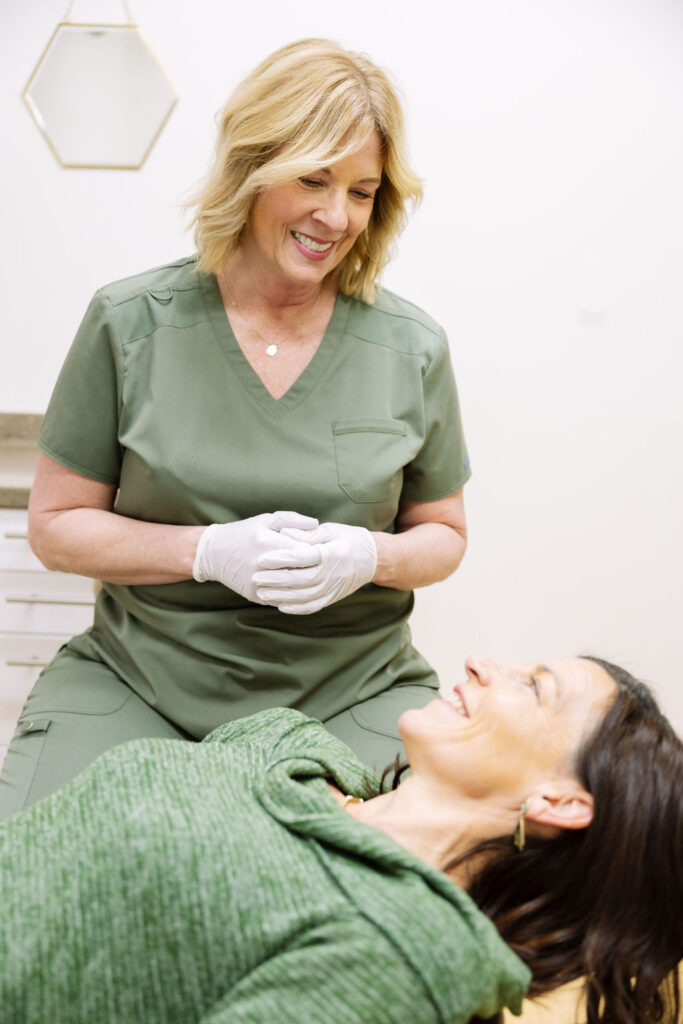What is Bioclear?
Bioclear is a minimally invasive form of restoration that uses an innovative technique to effectively treat black triangles, cavities, and aesthetic concerns, while preserving the organic tooth structure and delivering natural-looking results. At Dr. Sharon Dickerson, we combine this technology with our biological approach to dentistry, providing our patients with comprehensive & holistic oral care.
5 Benefits of Bioclear
- Minimally Invasive Alternative to Crowns and Veneers
- When treating damaged and decayed teeth with crowns or esthetic problems with porcelain veneers, a certain portion of the tooth structure must be ground away. These traditional techniques have been shown to statistically increase the potential for nerve death within the tooth which often leads to root canal treatment or extraction.1, 2
- Conversely, when addressing damaged teeth or esthetics concerns with Bioclear, the natural tooth formation is largely maintained. In turn, this vastly minimizes the risk of nerve damage and/or tooth loss. Furthermore, the unique Bioclear process incorporates techniques that have been shown to reduce post-care sensitivity, strengthen tooth structure, and deliver stunningly beautiful results.3

- Cost-Effective Approach
- Bioclear offers a more affordable option when compared with treatment such as large, back-tooth crowns and/or porcelain veneers.
- Optimal Technology for Addressing Black Triangles
- Stemming from a variety of causes, nearly 30% of adults present with gingival embrasures, more commonly known as black triangles.4 Not only can these dark spaces be of cosmetic concern for patients, but they also create an environment where food debris often becomes trapped, leading to plaque buildup and decay. Bioclear offers an innovative solution for repairing black triangles, creating a more stable oral environment and thus ultimately elevating the vitality of the entire systemic body.

- Immediate Results
- Depending upon the level of care required, Bioclear treatment can often be administered within one appointment. Many patients express that the process is pain-free and pleasantly easeful, and they are delighted to leave the office with same-day transformative results.
- Longer-Lasting Solution
- Unlike traditional crowns and veneers, Bioclear offers a durability that can extend 10 years or longer. Additionally, with its stain-resistant composition and ability to easily address any necessary repairs, it affords patients a long-term and reliable option.
How Bioclear Works
The Bioclear treatment is administered using sets of carefully crafted forms which are then filled with a biocompatible composite material. After the form is removed, the dentist implements their masterful artistry in sculpting the final configuration that ultimately results in a customized, healthy, and vital smile.
The Bioclear Process Step-by-Step
The Bioclear treatment involves six key steps performed by your dentist:
- Disclosing solution is applied to identify and remove biofilm on teeth
- The tooth surface is gently cleaned using a fine powder
- Custom matrices are selected and placed below the gumline
- Biocompatible etching opens pores in enamel for restoration material to adhere
- Heated composite resin is injected into the matrix
- Matrices are removed and restorations are shaped & polished
Bioclear uses state-of-the-art materials for a natural, seamless appearance. Once hardened and polished, Bioclear restorations are stain-resistant and can last 15-20 years with proper care.
Preserves Tooth Structure
Unlike veneers which require reshaping teeth, Bioclear is minimally invasive and conserves healthy tooth enamel. Only damaged/decayed portions are conservatively removed, making Bioclear an ideal option for those seeking to avoid aggressive procedures.
Single-Visit Treatment
Bioclear allows individuals to receive a brand new smile in just one appointment! This process removes the need for temporary veneers or multiple visits.
Ideal Candidates for Bioclear
If you have chips, cracks, gaps, black triangles, or other cosmetic dental concerns, Bioclear may be right for you. It’s an affordable way to transform your smile without aggressive teeth reshaping required for veneers.

Is Bioclear right for you?
When determining if Bioclear is appropriate for you, Dr. Dickerson will begin by facilitating a comprehensive exam. During this appointment, she will seek to understand your highest oral health priorities, while also diagnosing the root cause of any disharmony within the oral environment. With this knowledge, you and your doctor can then decide if Bioclear offers the best solution for your unique dental requirements.
Should you decide to progress with Bioclear treatment at Dr. Sharon Dickerson, we can assure you that you are in expert hands. Dr. Dickerson has been providing Bioclear restorations for many years and has received professional accolades for her level of proficiency.
To get the most out of your smile makeover, many patients choose to pair Bioclear with advanced treatments like laser dentistry. Our Denver laser dentistry options can enhance comfort, reduce inflammation, and improve long-term results—especially when addressing gum symmetry or prepping the area with precision.
To learn more about Bioclear and the care we provide at Dr. Sharon Dickerson DDS, we welcome you to contact us at 720.842.7002.
Frequently Asked Questions About Bioclear
Citations
- https://www.sciencedirect.com/science/article/abs/pii/S0099239986802023
- http://www.quintpub.com/userhome/qi/qi_27_10_brannstrom_10.pdf
- https://www.bioclearmatrix.com/why-bioclear/
- Kurth J, Kokich V. Open Gingival Embrasures after orthodontic treatment in adults: prevalence and etiology. Am J Orthod Dentofacial Orthop 2001; 120: 116-123

